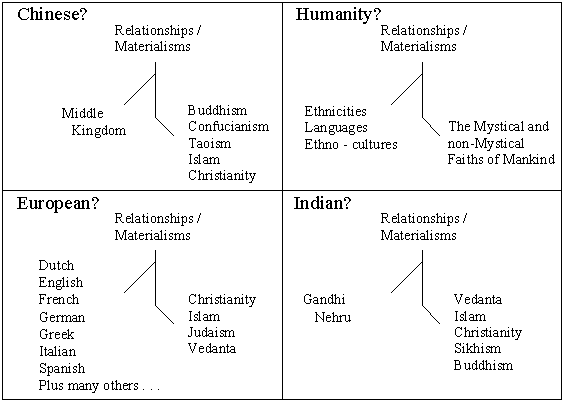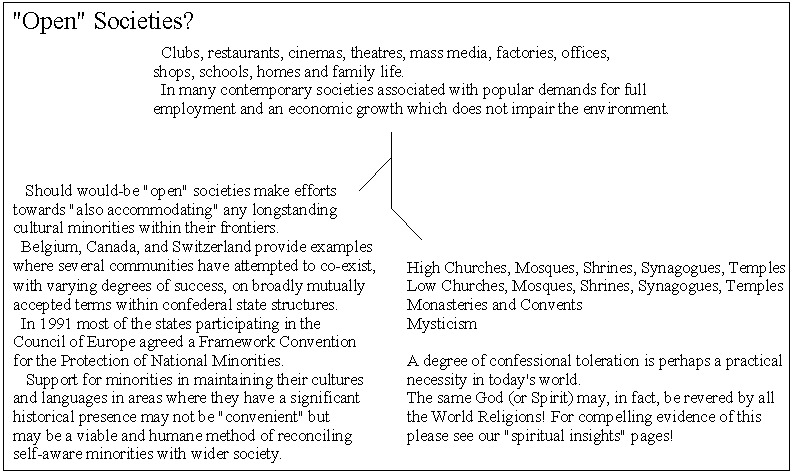![[the atman which is brahman relationships ultimate reality definition define describe]](../local/enlightenment.gif)
the atman which is brahman relationships definition thou art that define describe
atman which is brahman indian philosophy vedic philosophy ultimate reality![[the atman which is brahman relationships ultimate reality definition define describe]](../local/enlightenment.gif) the atman which is brahman relationships definition thou art that define describe |
|
|||
|
Indian Vedic philosophy speaks of " The
Atman which is Brahman " and the perceived relationships between Atman ~ being the "Self" ~ and Brahman
~ being the "World Soul" (and an Ultimate Reality) ~ are central to the religiously inspired world view of most Hindus!
The Mahavakyas, (or Great Sayings), of the UpanishadsPrajnanam Brahma - Consciousness is Brahman(Aitareya Upanishad 3.3, of Rig Veda) Ayam Atma Brahma - This Self is Brahman (Mandukya Upanishad 1.2, of Atharva Veda) Tat Tvam Asi - Thou art that (Chandogya Upanishad 6.8.7, of Sama Veda, Kaivalya Upanishad) Aham Brahmasmi - I am Brahman (Brhadaranyaka Upanishad 1.4.10, of Yajur Veda, Mahanarayana Upanishad) In order to attempt to describe Atman and Brahman or to offer definitions one could do worse than to demonstrate how they are viewed within such central Vedic-Hindu spiritual writings as the Upanishads and Bhagavad Gita:- The Self which is free from sin, free from old age, from death and from grief, from hunger and thirst, which desires nothing but what it ought to desire, and imagines nothing but what it ought to imagine, that it is which we must search out, that it is which we must try to understand. He who has searched out that Self and understands it, obtains all worlds and all desires. Khândogya-Upanishad 8.7.1
Khândogya-Upanishad 3.14 1, 3Thou art that ~ Ultimate RealityWhen Svetaketu was twelve years old he was sent to a teacher, with whom he studied until he was twenty-four. After learning all the Vedas, he returned home full of conceit in the belief that he was consummately well educated, and very censorious.His father said to him, ' Svetaketu, my child, you who are so full of your learning and so censorious, have you asked for that knowledge by which we hear the unbearable, by which we per- ceive what cannot be perceived and know what cannot be known ? ' 'What is that knowledge, sir?' asked Svetaketu. His father replied, 'As by knowing one lump of clay all that is made of clay is known, the difference being only in name, but the truth being that all is clay so, my child, is that knowledge, knowing which we know all.' 'But surely these venerable teachers of mine are ignorant of this knowledge; for if they possessed it they would have imparted it to me. Do you, sir, therefore give me that knowledge.' ' So be it,' said the father. . . . And he said, ' Bring me a fruit of the nyagrodha tree.' 'Here is one, sir.' 'Break it.' 'It is broken, sir.' 'What do you see there?' ' Some seeds, sir, exceedingly small.' ' Break one of these.' 'It is broken, sir.' 'What do you see there?' 'Nothing at all.' The father said, 'My son, that subtle essence which you do not perceive there in that very essence stands the being of the huge nyagrodha tree. In that which is the subtle essence all that exists has its self. That is the True, that is the Self, and thou, Svetaketu, art That.' 'Pray sir,' said the son, 'tell me more' 'Be it so, my child,' the father replied; and he said, 'Place this salt in water, and come to me tomorrow morning.' The son did as he was told. Next morning the father said, ' Bring me the salt which you put in the water.' The son looked for it, but could not find it; for the salt, of course, had dissolved. The father said, ' Taste some of the water from the surface of the vessel. How is it?' 'Salty.' ' Taste some from the middle. How is it? ' 'Salty.' 'Taste some from the bottom. How is it?' 'Salty.' The father said, 'Throw the water away and then come back to me again.' The son did so ; but the salt was not lost, for salt exists for ever. Then the father said, 'Here likewise in this body of yours, my son, you do not perceive the True; but there in fact it is. In that which is the subtle essence, all that exists has its self. That is the True, that is the Self, and thou, Svetaketu, art That.' From the Chandogya Upanishad
Thus the ultimate goal and Absolute of Hinduism as perceived by Vedic philosophy is termed " Brahman " in Sanskrit. The word comes from the Sanskrit verb root brh, meaning "to grow". Etymologically, the term means "that which grows" (brhati) and "which causes to grow" (brhmayati). Whilst Indian philosophy ( aka Vedic philosophy ) hold that the Atman or "Self" "is" Brahman ~ the "World-Soul" ~ such relationships are placed within broader perspectives by Vedic Philosophy further holding that this World Soul should itself be regarded as being the Three-in-One God known as the Trimurti. Brahma-the Creator, Vishnu-the Preserver, and Shiva-the Destroyer, are all perceived as being aspects or manifestations of the One-ness which is Brahman. Notwithstanding the view that Mystical Union is with the Atman which is Brahman several very remarkable spiritual teachers and guides who have appeared from time to time across the ages are considered, by the Vedic-Hindu tradition, to have been incarnations of the Lord Vishnu!!! This may effectively provide something of a bridge towards
traditionally monotheistic cultures which view Mystical Union as
being purely spiritual rather than with existence in ALL its
manifestations. Instances where Vedic Religion and Philosophy
|
|

A celebrated American Man of Letters named Ralph Waldo Emerson wrote that:-
"...man is a bundle of relations, a knot of roots, |

In old Rome the public roads beginning at the Forum proceeded north, south, east, west, to the centre of every province of the empire, making each market-town of Persia, Spain, and Britain pervious to the soldiers of the capital: so out of the human heart go, as it were, highways to the heart of every object in nature, to reduce it under the dominion of man. A man is a bundle of relations, a knot of roots, whose flower and fruitage is the world. His faculties refer to natures out of him, and predict the world he is to inhabit, as the fins of the fish foreshow that water exists, or the wings of an eagle in the egg presuppose air. He cannot live without a world.
In an essay entitled "The Over-Soul" Ralph Waldo Emerson wrote that:-
"...The soul looketh steadily forwards, creating a world before her, leaving worlds behind her. She has no dates, nor rites, nor persons, nor specialties, nor men. The soul knows only the soul; the web of events is the flowing robe in which she is clothed. ..." |
That which is nearest is least observed. The Atman is the nearest of the near, therefore a careless and unsteady mind gets no clue to the Atman. But one who is alert, calm, self-restrained, and discriminating, ignores the external world and, diving more and more into the inner world, realizes the glory of the Atman and becomes great.
Vivekananda
Stand upon the Atman, then only can we truly love the world. Take a very, very high stand; knowing our universal nature, we must look with perfect calmness upon all the panorama of the world.
Vivekananda
This is the secret of spiritual life: to think that I am the Atman and not the body, and that the whole of this universe with all its relations, with all its good and all its evil, is but as a series of paintings — scenes on a canvas — of which I am the witness.
Vivekananda
Start of
The Atman which is Brahman relationships
in Indian Vedic Philosophy